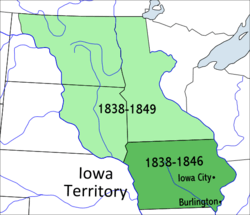Iowa Territory
| Territory of Iowa | |||||
| Organized incorporated territory of the United States | |||||
| |||||
 | |||||
| Capital | Burlington (1838–1841) Iowa City (1841–1849) | ||||
| Government | Organized incorporated territory | ||||
| Governor | |||||
| • | 1838–1841 | Robert Lucas | |||
| • | 1841–1845 | John Chambers | |||
| • | 1845–1849 | James Clarke | |||
| History | |||||
| • | Organized from Wisconsin Territory | July 4, 1838 | |||
| • | Statehood of Iowa | December 28, 1846 | |||
The Territory of Iowa was an organized incorporated territory of the United States that existed from July 4, 1838, until December 28, 1846, when the southeastern portion of the territory was admitted to the Union as the State of Iowa. The remainder of the territory would have no organized territorial government until the Minnesota Territory was organized on March 3, 1849.
History

Most of the area comprising the territory was originally part of the Louisiana Purchase and was a part of the Missouri Territory. When Missouri became a state in 1821, this area (along with the Dakotas) effectively became unorganized territory. The area was closed to white settlers until the 1830s, after the Black Hawk War ended. It was attached to the Michigan Territory on June 28, 1834. At an extra session of the Sixth Legislative Assembly of Michigan held in September, 1834, the Iowa District was divided into two counties by running a line due west from the lower end of Rock Island in the Mississippi River. The territory north of this line (which started just south of the present-day Davenport) was named Dubuque County, and all south of it was Demoine County. When Michigan became a state in 1836 the area became the Iowa District of western Wisconsin Territory—the region west of the Mississippi River.
The original boundaries of the territory, as established in 1838, included Minnesota and parts of the Dakotas, covering about 194,000 square miles (500,000 km2) of land.
Burlington was the stop-gap capital; Iowa City was designated as the official territorial capital in 1841.[1]
When Iowa became a state on December 28, 1846, no provision was made for official organization of the remainder of the territory.[2] Morgan L. Martin, the Wisconsin territorial delegate to congress, pushed through a bill to organize a territory of Minnesota which would encompass this land. While the bill passed in the house, it did not pass the senate. In the following session a bill by Stephen A. Douglas was introduced in the senate but also did not pass. The situation was resolved when Minnesota Territory was organized on March 3, 1849, the day before the close of congress.[3]
Governance
Governors of Iowa Territory
- Robert Lucas, appointed 1838.
- John Chambers, appointed 1841.
- James Clarke, appointed 1845.
Secretaries of Iowa Territory
- William B. Conway, appointed 1838; died in office, November 1839.
- James Clarke, appointed 1839.
- O.H.W. Stull, appointed 1841.
- Samuel J. Burr, appointed 1843.
- Jesse Williams, appointed 1845.
Congressional delegates
- William W. Chapman 25th and 26th Congresses, 1838–1840
- Francis Gehon, irregularly "elected" in 1839, but never served as delegate
- Augustus C. Dodge, in the 27th, 28th, and 29th Congresses, 1840–1846
See also
- Historic regions of the United States
- History of Iowa
- Territorial evolution of the United States
- Territory of France that encompassed land that later became part of the Territory of Iowa:
- Louisiane, 1682–1764 and 1803
- Territory of Spain that would later be returned to France:
- Luisiana, 1764–1803
- Territory of the United Kingdom that encompassed land that later became part of the Territory of Iowa:
- Rupert's Land, 1670–1870
- U.S. territories that encompassed land that later became part of the Territory of Iowa:
- Louisiana Purchase, 1803–1804
- District of Louisiana, 1804–1805
- Territory of Louisiana, 1805–1812
- Territory of Missouri, 1812–1821
- Territory of Michigan, 1805–1837
- Territory of Wisconsin, 1836–1848
- U.S. territories that encompassed land that was previously part of the Territory of Iowa:
- Territory of Minnesota, 1849–1858
- Territory of Dakota, 1861–1889
- U.S. states that encompass land that was once part of the Territory of Iowa:
- State of Iowa, 1846
- State of Minnesota, 1858
- State of North Dakota, 1889
- State of South Dakota, 1889
- Territory of France that encompassed land that later became part of the Territory of Iowa:
References
- ↑ http://iagenweb.org/history/soi/soi31.htm
- ↑ "Chapter 2 — Founding Documents" (PDF). 2013 - 2014 Minnesota Legislative Manual (Blue Book) (PDF). Saint Paul, MN: Office of the Minnesota Secretary of State. 2013. p. 50. Retrieved August 19, 2014.
- ↑ Shortridge, Wilson P. (August 1919). "Henry Hastings Sibley and the Minnesota Frontier". Minnesota History Bulletin. 3 (3): 115–125. Retrieved August 19, 2014.
